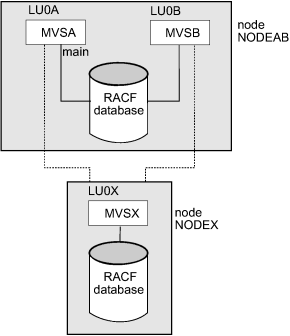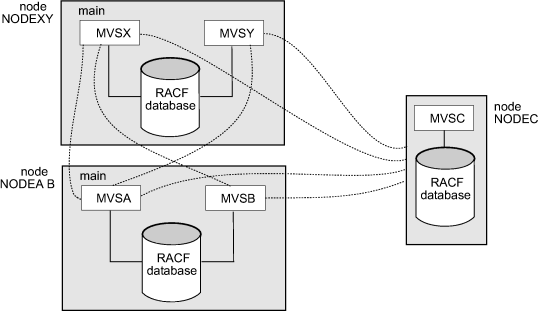 z/OS Security Server RACF System Programmer's Guide
z/OS Security Server RACF System Programmer's Guide
 z/OS Security Server RACF System Programmer's Guide
z/OS Security Server RACF System Programmer's Guide
|
Previous topic |
Next topic |
Contents |
Contact z/OS |
Library |
PDF
Single-system nodes and multisystem nodes z/OS Security Server RACF System Programmer's Guide SA23-2287-00 |
|
|
An RRSF node can be either a single-system node or a multisystem node. A single-system RRSF node consists of only one MVS™ system image. A multisystem RRSF node consists of multiple MVS system images that share a RACF® database. For a multisystem RRSF node, you designate one of the MVS system images to be the main system. The main system receives most of the RRSF communications sent to the node. The other systems in the node are known as nonmain systems. Figure 1 shows an RRSF network containing a single-system node and a multisystem node. Figure 1. An RRSF network containing
a single-system node and a multisystem node. NODEAB is
a multisystem node. NODEX is a single system node.
 Main systems in a multisystem RRSF node can send RRSF requests to main systems on remote multisystem RRSF nodes, and to single-system RRSF nodes. In addition, when main systems receive requests from remote systems (main or nonmain), they send output and notifications back to the system that originated the request. Nonmain systems in a multisystem RRSF node can send RRSF requests to main systems on remote multisystem RRSF nodes, and to single-system RRSF nodes. They cannot send RRSF requests to other remote nonmain systems, or to other local systems (nonmain or main). Most RRSF communications sent to the multisystem RRSF node are
received by the main system, including:
The following types of RRSF communications can be received by any
system in a multisystem node:
When the local node is a multisystem node, a system in the node is referred to as either the local system or a local peer system. The local system is the system in the local multisystem RRSF node whose SYSNAME (defined by the TARGET command) matches the current CVTSNAME. A local peer system is a system in the local multisystem RRSF node whose SYSNAME (defined by the TARGET command) does not match the current CVTSNAME. All of the systems in a local multisystem RRSF node are referred to as member systems of the node. Figure 2 shows an RRSF network containing two multisystem nodes, NODEXY and NODEAB, and one single-system RRSF node, NODEC. Multisystem node NODEXY contains two systems, MVSX and MVSY. Multisystem node NODEAB contains two systems, MVSA and MVSB. Figure 2. An RRSF network with two multisystem
nodes and one single-system node
 On NODEAB, from the perspective of system MVSB:



|
 Copyright IBM Corporation 1990, 2014 Copyright IBM Corporation 1990, 2014 |